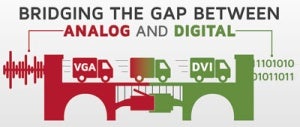
Changing generations of computer signals can lead to high follow-up costs. To guarantee a long operating life of existing systems, G&D developed the Bridge function to bridge the gap between analog and digital worlds.
When extending and switching computer signals via KVM, the main focus is always on the video signal, the most critical component during transmission. However, transmission depends on the video signal since high resolutions and crystal-clear images without any latencies are extremely important.
In the world of computers, the analog video signal VGA has been playing a leading role for more than two decades. Any resolutions based on VGA were optimised for CRT displays. After the introduction of LCD displays, the analog signal had to be converted into a digital signal.
Following VGA, the digital DVI signal didn’t need to be converted and allows for much higher resolutions than VGA, but changing signal standards within the world of computers can cause immensely high follow-up costs.
KVM outlives generations of signals
Analog KVM matrix systems from Guntermann & Drunck (G&D) run over years, since they are known for being robust, solid and reliable. Therefore, it wouldn’t be wise to replace the system while their return-on-investment is still active, not to mention the effort required by a new installation. Yet, up-to-date, DVI-based computers must be integrated into KVM systems.
Luckily, G&D products even survive changing generations of signals. To be able to continue using VGA-based KVM matrix systems and to integrate digital state-of-the-art solutions, German KVM pioneers G&D now offers their customers the Bridge function. The function figuratively bridges the gap between and unites existing analogue and digital matrix systems.
Simplifying complicated switching
The theoretical concept of the Bridge function is similar to setting up a cascade. The analog matrix (CATCenter NEO) is integrated into the digital system (ControlCenter-Digital or DVICenter). A computer module with analog-to-digital converter (VGA-CPU) integrates the CATCenter NEO’s analog user module (UCON) into the digital matrix.
And as always, G&D puts usability first. The logical connection between both systems saves the users from clicking through various different OSDs.
Users don’t even realise the physical and technical processes running in the background. They simply use their VGA computers in their digital working environment. The video signal becomes secondary. Every source is only one key away. All accessible computers are displayed in a clearly-arranged list so that users can focus on their actual work.
Advantages of the Bridge function
In addition to accessing analogue and digital worlds with one single system, the Bridge function offers further advantages for all affected:
- IT staff:
- No complex reconstructions necessary
- Sophisticated rights assignment
- Expansions with entirely digital systems possible
- Easy migration of the analog matrix into the digital matrix to permanently continue with full operation
- Users:
- Easy selection of computers via OSD
- Overview of all connected computers
- Operation over one system via one master matrix level
- Existing expansions (Push/Get and TradeSwitch function, external media control, etc.) gain new features from the digital matrix
- Finances:
- Future-proof installation
- High return on investment through longer life cycle of analog KVM systems
- Increased safety of investments despite the change of signals from analog to digital since existing and new IT systems can be operated together
At upcoming trade fairs, the team of G&D look forward to answering questions about the bridge function.
For more information, please contact G&D.

